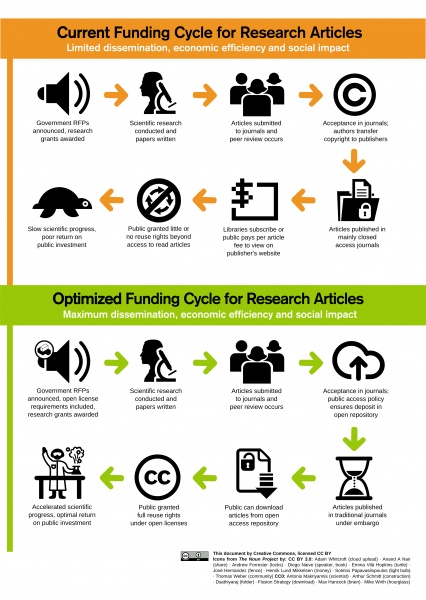Academic scholarship relies on the ability to access and build upon existing knowledge. Copyright protections greatly impact scholarship by shaping whether and how scholars and students access and use existing works. Two separate, related movements have evolved to address the restrictions imposed by copyright. In particular, these open movements increase access to kinds of information that have traditionally been published in expensive academic journals and textbooks.
These movements are Open Access (OA) and Open Education (OE). While their aims are similar in many ways, Open Access is about academic journal publishing and Open Education is about textbooks and educational materials more broadly.
In a traditional research publishing model, research is often funded by governments and public agencies and written by scholars who write and review research articles for no additional compensation. These articles are published in academic journals, with the author usually transferring copyright for their work to the journal publisher. Then, the publisher sells access to the journal, usually at costs that are prohibitive to individuals and smaller organizations. Even for those can afford access, copyright restricts users' ability to fully make use of published research.
Even though much research is publicly funded or funded in the public interest by foundations, results become largely inaccessible to the public as a result of this traditional publishing model.
SPARC defines Open Access as "the free, immediate, online availability of research articles coupled with the rights to use these articles fully in the digital environment."
In this alternative model, authors retain copyright when their articles are published, and articles are made freely available online through institutional repositories or open access journals. These articles are published with open CC licenses to further free up how others can build on this knowledge.
Instead of the end user (subscriber) absorbing the full costs of publication, costs are usually factored into production of OA journals. Models vary, but many OA journals charge an Article Processing Charge (APC), which is paid by the author or the author's institution.

“Research Article Cycles,” by Billymeinke. CC BY 4.0.
Open Access articles are beneficial for students at CofC:
Open Access journal publishing is beneficial for faculty at CofC:
Academic textbook publishing is similar to academic journal publishing in some key ways--textbooks are written by researchers and scholars who receive little of the proceeds when their work is published by traditional textbook producers.
In the Open Education movement, textbook production is funded by educational stakeholders, rather than academic publishers. Universities and consortia support the production of online textbooks written by faculty. These textbooks, known as Open Educational Resources (OER), are openly licensed and shared freely online.
In addition to textbooks, OER includes videos, test banks, lecture slides, and many other curricular materials that are openly licensed and freely available.
The following 5R characteristics are associated with OER:
This list of 5 Rs was created by David Wiley and published freely under a Creative Commons Attribution 4.0 license at http://opencontent.org/definition/.
The primary benefit of OER for students is cost savings. Traditional textbook costs can add up to hundreds of dollars each semester, but OER are free!
This is not the only important benefit. When your instructor uses an OER, you and your classmates can all access that text from the very beginning of the course--no more searching for cheaper editions online and then waiting for them to arrive, or sharing a textbook with a friend, or waiting to see if the book is really necessary.
Many instructors using OER also take the opportunity to customize their course in ways that make it more meaningful.
While transitioning a course to OER can be time consuming, the benefits for faculty are numerous:
 Copyright Guide by Gretchen Scronce is licensed under a Creative Commons Attribution 4.0 International License (CC-BY).
Copyright Guide by Gretchen Scronce is licensed under a Creative Commons Attribution 4.0 International License (CC-BY).